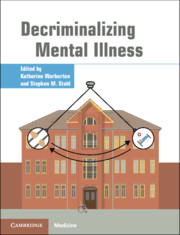Book contents
- Decriminalizing Mental Illness
- Decriminalizing Mental Illness
- Copyright page
- Contents
- Contributors
- Part I Introduction/Description of the Problem
- Part II Solutions
- Part III Psychopharmacological Treatment Considerations
- Chapter 18 Dopamine Antagonist Antipsychotics in Diverted Forensic Populations
- Chapter 19 Monitoring and Improving Antipsychotic Adherence in Outpatient Forensic Diversion Programs
- Chapter 20 Pharmacological Treatment of Violence in Schizophrenia
- Part IV Nonpsychopharmacological Treatment Considerations
- Part V Criminal Justice and Social Considerations
- Index
- References
Chapter 20 - Pharmacological Treatment of Violence in Schizophrenia
from Part III - Psychopharmacological Treatment Considerations
Published online by Cambridge University Press: 19 October 2021
- Decriminalizing Mental Illness
- Decriminalizing Mental Illness
- Copyright page
- Contents
- Contributors
- Part I Introduction/Description of the Problem
- Part II Solutions
- Part III Psychopharmacological Treatment Considerations
- Chapter 18 Dopamine Antagonist Antipsychotics in Diverted Forensic Populations
- Chapter 19 Monitoring and Improving Antipsychotic Adherence in Outpatient Forensic Diversion Programs
- Chapter 20 Pharmacological Treatment of Violence in Schizophrenia
- Part IV Nonpsychopharmacological Treatment Considerations
- Part V Criminal Justice and Social Considerations
- Index
- References
Summary
Known predictors of violence include patients with co-morbid substance use disorders (SUDs) and nonadherence with prescribed treatments, those with co-morbid personality disorders, and those with frequent relapses/arrests/civil commitments.
- Type
- Chapter
- Information
- Decriminalizing Mental Illness , pp. 210 - 220Publisher: Cambridge University PressPrint publication year: 2021

